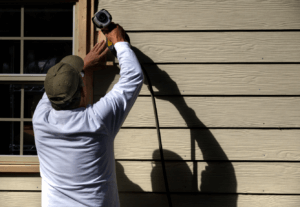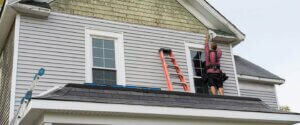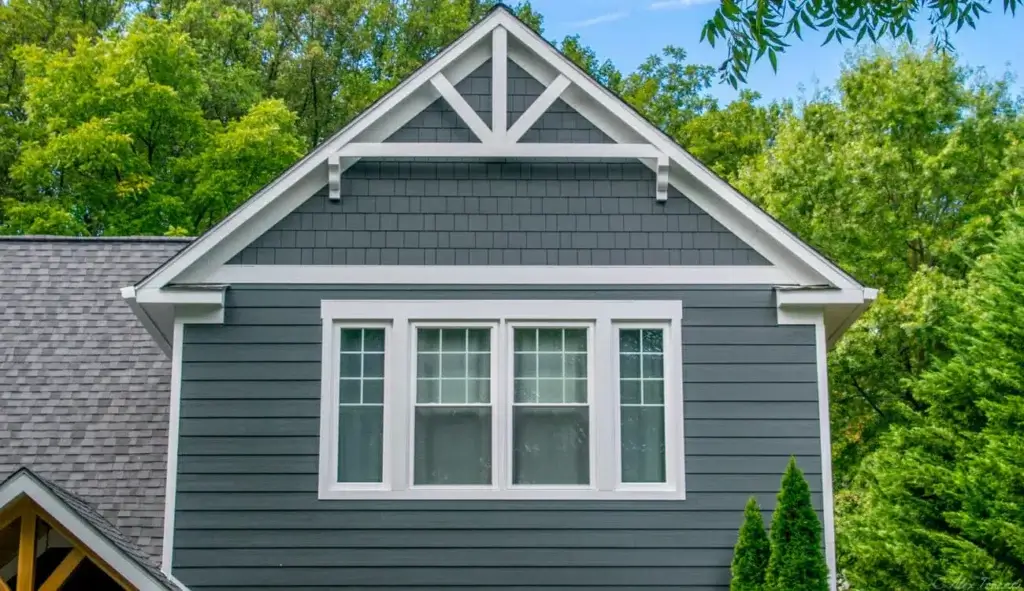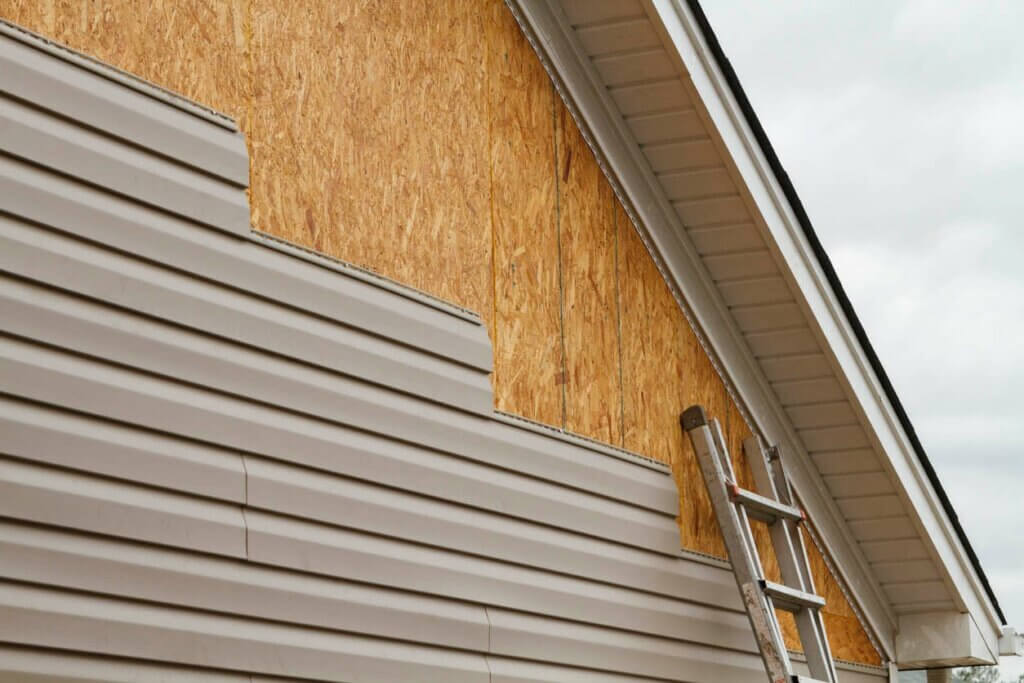Home exteriors play a crucial role in protecting the structure from the elements while also enhancing its aesthetic appeal. Siding, in particular, serves as a protective barrier, shielding your home from wind, rain, and other environmental factors. But how do you know when it’s time to replace siding? Allegiant Exteriors, a leading roofing contractor known for its expertise in home exterior services, sheds light on key indicators that suggest it might be time for an upgrade.

If you find yourself constantly repairing or maintaining your siding, it might be more cost-effective to replace it. Frequent issues such as cracks, warping, or rot indicate that the siding is no longer providing optimal protection.
An unexpected rise in energy bills can sometimes be traced back to inefficient siding. Good siding offers insulation, keeping your home warmer in the winter and cooler in the summer. If your energy costs are creeping up, it could be a sign that your siding is failing.
While siding is designed to withstand the elements, excessive fading and discoloration are signs that it’s losing its durability and aesthetic appeal. This not only impacts your home’s look but may also indicate a breakdown in the material’s integrity.
Water infiltration is a serious concern. If you notice mold, mildew, or signs of water damage inside your home, it might be due to failing siding. Replacing your siding can prevent further structural damage and improve your home’s health.
Sometimes, the decision to replace siding is driven by the desire to update your home’s exterior. New siding can dramatically improve curb appeal, increasing your home’s value and making it stand out in the neighborhood.
Determining the right time to replace siding involves considering various factors, including the age of your siding, the extent of damage, and your energy efficiency needs. Allegiant Exteriors offers comprehensive home exterior services, including siding replacement, to ensure your home remains beautiful and protected.
To understand more about your siding options and to determine if now is the time for an upgrade, schedule a free inspection with us. Our team of experts is ready to assess your needs and recommend the best solutions to keep your home in top condition.
Siding is one of the most overlooked aspects of home improvement. It’s such a small detail, but it can significantly impact your house’s overall appearance and value. Whether you’re looking to add siding to the outside of an existing structure or a new building, there are many factors that you will have to consider when choosing which type of siding will look best on your home.
This article will cover some common types of siding and how they might appeal to different homeowners.
Choosing the correct type of siding can make a big difference in your home’s appearance and value. If you’re looking to make a significant impact on the appearance of your home, consider choosing a siding that will complement the style of your house.
In addition to considering the look and feel of the siding, other factors should be considered when choosing which type of material is right for your house. For example: how much will it cost?
Considering the siding budget is one of the first questions people ask when deciding which type of siding they want installed in their homes. While some types may be more expensive than others (wood vs. vinyl), it’s essential also to consider how much maintenance and repairs will cost over time, as well as any potential replacements down the road.
Wood siding is a traditional choice. It’s often made of redwood or cedar, which can be expensive. This type of material has a warm, natural aesthetic that suits some architectural styles; however, if your home is located in a region of the country where extreme weather is expected (such as the Pacific Northwest), this option may not be ideal because it can easily break and crack when exposed to heavy winds.
If you live in a frigid climate, wood siding is the best choice for your home. Wood is the most expensive type of siding and the most maintenance-intensive. But if you’re looking for something with that unforgettable traditional look, wood may be worth it. Wood gives your house a warm and welcoming look that will last for years—even decades!
Vinyl siding is the most popular choice for new homes since it’s durable and low maintenance. Vinyl can be installed over pre-existing siding, which means you’ll save on labor costs. Vinyl also is a cost-effective choice because it is one of the cheapest siding options to purchase.

One type of siding that is gaining popularity is fiber cement, also called “composite” or “pultruded.” It’s composed of cement and cellulose fibers, which makes it very durable. The finished product looks like real wood siding but doesn’t rot, warp or crack like natural wood.
Fiber cement has been around for years but has recently become popular with homeowners because it lasts so long—the typical lifespan is 40 years! It’s also fire resistant and can be painted to match your house, making it an attractive option if you’re hoping to find something that will blend in with the rest of your home’s look while still being resilient enough to withstand harsh weather conditions year after year without needing any repairs or replacements (like some other types of siding).
While fiber cement is more expensive than other types of siding options on this list, you’ll get what you pay for: a quality product that won’t need replacement anytime soon!
Aluminum is a lightweight, durable and attractive choice for siding on your home. It’s also easy to install, so you won’t have to call in a contractor if you don’t want to. Aluminum makes sense if you live in an area prone to flooding or high winds, as these conditions do not easily damage it. Aluminum siding can be ordered with different textures and colors that match any home style.
Aluminum siding will last longer than other materials if your home sits on a coastline or near saltwater; however, it’s also more susceptible to corrosion over time due to salt buildup on its surface. This can lead to premature wear on the metal material itself as well as additional maintenance costs such as repainting every few years due to discoloration caused by oxidation caused by exposure to sun rays–something that won’t happen with other types like stucco or vinyl since they’re not made from metals like aluminum but instead has their unique compositions.
Stucco is another popular exterior siding option. Stucco is a mixed combination of cement, sand, and water that hardens over time to create a protective layer on your home. It’s often used in areas prone to high winds or hurricanes because it can withstand hurricane-force winds without damage.
Stucco is not recommended for homes located in areas with extreme temperature changes as it tends to crack when exposed to temperature changes too quickly.
This is a significant consideration if you plan to sell your home soon. As you probably know, the condition of the siding on the house can have a substantial impact on its resale value. You’ll want to ensure that whatever style of siding you choose will hold up well over time and maintain its appearance.
For example, vinyl siding is one of the least expensive options on the market today. However, it comes with some challenges: It tends to fade after only a few years in direct sunlight; it’s also more prone than other materials to cracking and splitting, and repairs can be tricky if necessary. On top of that, vinyl isn’t as durable as stucco or fiber cement—meaning that over time, you may need more frequent replacements than other homeowners who opted for different materials when building their homes.
Siding is an extremely important investment in your home and can make a huge difference in your home’s appearance. If you’re considering replacing your siding, consider the type of siding most appropriate for your style and the style of your home.
Ideally, it is always best to choose a type of siding that will last as long as possible while still looking good. Which factors are the most important to you: cost or resale value? Maintenance costs? Durability? These are all questions you may need to ask yourself as you navigate the new siding process.
If you have further questions about your siding needs, contact your local siding professionals at Allegiant Exteriors to keep your best interests in mind.
Read our reviews to learn more about us.
Siding is the most important part to any house. It is what protects the interior frame and design of the house from all the weather elements. Deciding on which type of siding to invest in is essential to the future well-being of the home. It will also contribute to the decorative layout and exterior design. Although there are many siding alternatives to choose from in the market, this article covers Hardie plank siding.
This siding was developed by the James Hardie company and is considered as one of the best siding materials available. Is it the right investment for you? What are the pros and cons of this type of this type of siding? In this article, we’ll cover that discussion.

As with any quality product, you want it to be durable and reliable. With the Hardie plank siding, you are getting your money’s worth and more. The siding is composed of cement, sand and cellulose fibers, creating a unique combination that is made to last. As far as the lifespan, the siding can last up to 50 years. Of course, the siding will be able to withstand a wide array of weather conditions, including rain, snow, thunderstorms, ice, heat, humidity and more.
The design of the Hardie plank siding is also beautiful and can enhance your home’s layout just as you want. It comes with a variety of styles and colors to complement your home. Some of the Hardie plank designs also mimic wood siding products so that you can get the best of both worlds. The design of the Hardie plank also helps to seal your home perfectly. This will prevent any moisture from seeping into your home, which can lead to rotting wood, warping and unwanted repairs.
One disadvantage about traditional wood siding is that it can attract pests. However, with Hardie plank siding, you won’t have to worry about termites or carpenter ants. The boards are resistant to these pests and will make your investment well worth it. The sidings are also resistant to woodpecker damage. However, one thing that stands out above these benefits is its warranty. The James Hardie company offers reliable warranty for their products.
Hardie plank siding comes in a collection of different customizable designs and styles. Whether you want a traditional design for your home or a modernized layout, you can find exactly what you want.
Hardie plank siding is also fire resistant and isn’t combustible in any manner. Wood siding, on the other hand, can actually contribute to fueling a fire. Therefore, you can rest easy knowing that Hardie plank is completely safe and fire resistant.
If you’re looking to invest in Hardie plank siding, certified contractors are able to install your siding without any issue. The James Hardie company has trained contractors who are certified to do the work of installing the siding. This can give you the assurance that the siding will be installed by qualified installers.
Finally, maintaining the siding is also easy to do. We recommend cleaning your siding twice a year. You can clean the siding by using your garden hose and a medium nylon bristle to knock off any dirt.
While the Hardie plank siding has many pros, it does have a couple of cons. However, the pros outweigh the cons significantly, so we do recommend a final investment in Hardie plank. The upfront cost of the Hardie plank is more expensive than regular vinyl siding. However, it tends to be worth the investment because Hardie will last longer.
If you want to replace vinyl siding with Hardie plank, the installation process can be much different and take longer to install than vinyl siding. The siding itself is much heavier and can be a challenge to install on a house. This is why it is recommended to have qualified professionals like the Allegiant Exteriors company to install the Hardie siding. By doing this, you can rest assured of the installation process along with its reliable warranty.
Although maintenance is fairly low with the Hardie plank siding, you may need to repaint the siding after 15 years. However, painting it is fairly easy and can be done within a couple of days.
In the end, the pros definitely win. Although the Hardie plank siding can be a little expensive, it is worth the investment. In short, it is durable and resistant to a variety of weather elements. The siding will also last you for a long time.
Once you’re ready to have your new Hardie plank installed, remember to contact the Allegiant Exteriors company.
Check our our reviews to learn more about us.
Siding is one of the most important parts to any house. Its purpose is to protect the home from a variety of weather elements, such as rain or snow. The siding can even serve to protect your house from the sun’s rays in those hot summer days. When you’re deciding on which type of siding you want to get for your home, you will run into a few options, including natural wood siding, metal siding and of course vinyl siding.
This type of siding is made from a durable plastic design that works as an exterior wrap or finish for your home. In this article, we’ll concentrate on the best features along with some of the cons that vinyl siding offers. It is considered to be a great alternative for protecting your home. Let’s go over some of the pros and cons so that you can make an informed decision on your investment.

Low Maintenance – One attractive feature from vinyl siding is low maintenance. In fact, because of its slick surface and material, it can be easily cleaned with a water hose. Any dirt, cobwebs and other types of debris will quickly fall off with a spray of water.
Affordable – Saving money is important when you’re building a new home or renovating an existing one. Costs can quickly add up and investing in vinyl siding can actually save you money in the end. When you compare it to other sidings like fiber cement or wood siding, you may be able to spend somewhere between 30 to 50 percent less. Why? Well, the cost of vinyl has an edge amongst its competitors because it features panels that interlock together, which makes it easier to install. Make sure that you browse different siding suppliers to find the right choice for your home.
Durability – Even though vinyl siding is much more affordable than other types of siding, it doesn’t mean that it’s composed of cheap materials. Vinyl siding is one of the most durable and reliable sidings on the market. When the siding is properly installed, it will protect your home from for many years. Some homes with vinyl have lasted with the same siding for 20 years or more. It is also perfect to keep your home insulated, which can help to keep your home comfortable.
Beautiful Designs – Vinyl siding has certainly changed a lot within the past 30 years. Nowadays, it provides both a dependable alternative to protect your home and many designs that you can choose. This will include different vinyl colors, trims and more. You’ll also find different textures and profiles that can fit the layout of any home.
Installation – While installing vinyl siding is fast and easy, make sure that you hire someone who knows what they’re doing. Since this type of siding comes in panels with interlocking features, it’s important to lock these panels securely. Any missed panel that is not locked correctly can result in an open space into your home. This open space can let in moisture within boards leading to damp wood or mold in the future. With time, these panels will begin to separate if they’re not installed properly.
Property Value – Vinyl siding has many great advantages. However, when it comes to evaluating the value of your property, it can actually do more harm than good. The market usually values other types of siding more than vinyl, such as wood or even fiber cement. If you’re concerned that vinyl could devalue your property value, it may be best to opt for another alternative.
Painting – Can you paint vinyl siding? Many experts have had different opinions when it comes to painting vinyl siding that has faded. While a fresh coat of paint may brighten up the siding’s color, it’s essential to use quality paint and experienced painters to do the job right. Vinyl can be tricky to successfully paint over. If it’s not done correctly, the paint can begin to crack within just months. Another downside to this is that the overall paint job will come out more expensive than your regular painting project.
Cracking – Quality matters greatly in vinyl siding. Because vinyl is prone to cracking and much more easily breakable than other materials, you want to invest in quality. Although most siding can last for many years, your location can affect its overall lifespan. Natural weather elements in extreme conditions can damage your vinyl. This can include prolonged exposure to sun, rain, wind and freezing temperatures. With time, your siding will begin to crack.
Fading – As with any other material, fading happens sooner or later. However, with vinyl siding, the process can happen much faster, which depends on a variety of factors. First, you have to consider the color. Darker and bolder colors tend to fade much faster compared to lighter colors. Second, your vinyl siding will fade much faster if it’s situated in a place where direct sunlight hits the home.
Contact us with any questions about siding or to schedule a free estimate today. We are happy to walk you through any claims processes or assist with free inspections.
Check our our reviews to learn more about us.